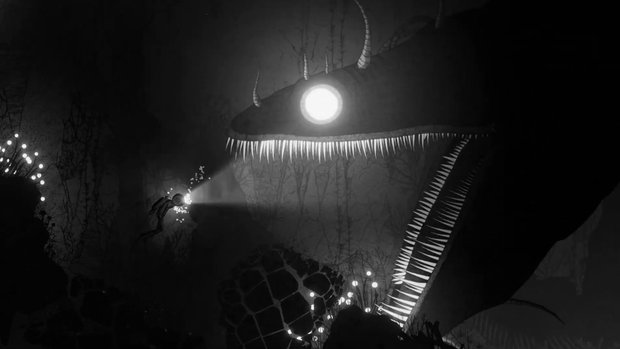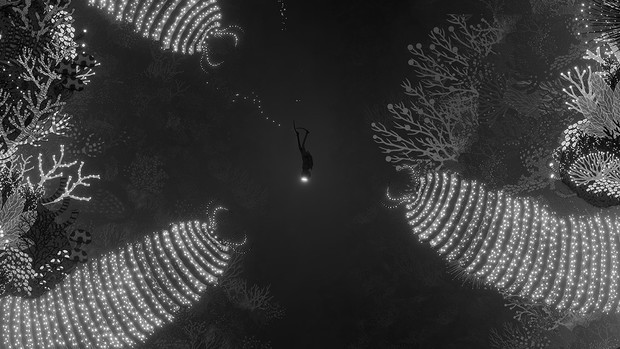SILT review – Black-and-white underwater odyssey a bit too predictably shallow

- 0 Comments
The world beneath the waves is one of boundless mysteries, making it the perfect setting for an adventure game. Spiral Circus Games’ SILT would seem to check all the boxes, dropping players into a surreal monochrome aquatic limbo to explore the beautiful (but equally dangerous) alien ecosystem, armed only with a single special ability to avoid dropping too far down the food chain. Yet for all the potential it has to surprise players, SILT ends up being surprisingly predictable. It’s not a poor game by any means, it just lacks the grandeur you’d expect of an undersea adventure and isn’t very rewarding as a result.
SILT opens with a diver regaining consciousness in a submerged cavern. Assuming control of the nameless diver, you’ll find your ankle chained to the ground, preventing you from swimming more than a few feet in any direction. Nearby, a fangtooth fish swims about. Here the game reveals that you can possess certain types of sea life, with a stream of light stemming out of your diver’s mask and attaching to the creature in question once the prompted “possess” button is pressed and held. Gaining control of the fangtooth, you can nibble through the chain, freeing yourself and beginning your exploration of the sea caves in which you find yourself further trapped.
At the end of this sequence, you’ll be transported to a central hub, which in turn leads to three other distinct areas that can only be accessed in a pre-defined order. Each area is blocked via a massive iron-jawed gate, and the game will direct you towards the correct one by having currents block you from moving in the wrong direction. The first of these areas is a flooded forest, followed by a factory, and finally by another set of sea caves.
As you progress, the environments become a bit more abstract, and one quickly gets the feeling this isn’t any ordinary body of water. The nameless diver simply carries on traversing the caves without any sign of panic or confusion, however, and the storytelling is reserved throughout the game, putting the onus on you to pull together bits of narrative from your surroundings and creatures you encounter, with the occasional cutscene panning or zooming out of a scene before returning control.

Along the way you’ll find other divers floating unconscious in the depths, and you can save these souls by using your possession skills to reawaken them, which achievement hunters and completionists will appreciate. There is no dialog between characters, or any writing or notes to read, leaving the mystery of how this little diver and his companions came to be in this strange place open to speculation. The endgame illuminates the larger scale of these lost souls a little more, but again, it’s not so much a narrative reaching its culmination as it is a grand setpiece to provide one last piece of organic storytelling.
Though some of the vistas are interesting, and may spur you to wonder about the bizarre nature of this world, few answers are given. Keeping the setting oblique is fine, but I couldn’t help feel it all fit together without much rhyme or reason. Despite some hints at worldbuilding, like libraries decorated with statues of titanic animalistic figures at the start of each new area, there isn’t any context as to how this place came to be submerged, or what each nightmarish area is supposed to represent. Instead, it’s more of a surreal mishmash of stuff sunk underwater because it looks cooler that way – and to be fair, it often does. This is all in keeping with the formula of Limbo, Inside and other puzzle-platformers of this kind, but the end result is a game I’m glad to have seen through once but probably won’t be interested in ever investigating again.
The graphics throughout are three-toned black and white, with the titular grey silt clouding the backdrops. There are numerous dark areas, but this deep-sea adventure is still light enough to appreciate the ocean’s splendor. The backdrops and foreground are multilayered, and the parallax effect goes a long way toward making you feel as though you are in a 3D space. Though none of the individual rooms are large enough to classify as labyrinthian, the dark recesses and blind corners keep you on your toes (if that’s possible underwater), and on the lookout for twitching antennae or beady eyes of camouflaged predators lying in wait.
The forest area is a creepy expanse of woodlands whose trees are populated by strange bird-like creatures, almost making you forget this place exists underwater at all. The factory begins as a corridor crawl, but as you make your way upwards, tall windows provide an expansive view of submerged structures on the horizon, aptly populated by electric eels and armored crabs, channeling their industrial surroundings. Finally, the sea caves are a series of rock caverns filled with throngs of hungry creatures waiting to jolt and devour unsuspecting prey.

The animations of both your diver and the sea creatures are great. Though it might look like a pop-up book from still screenshots, the game has a deceptively creepy stillness to it, with creatures animating smoothly, and quickly, as they dart out from the rocks to try to eat you. There is little in the way of music, at least not full tracks, though atmospheric electronic and orchestral arrangements do play from time to time, like during the credits, when you enter a new area, or when you defeat a boss. Sound effects are suitably subdued, being filtered through a submerged muffle. The piercing echoes of machinery moaning as it struggles to move underwater, for instance, prove quite eerie.
SILT supports controllers and seems like it would play better that way, but I played on PC using a keyboard. My hand cramped a bit, but I made it through without much discomfort. WASD moves the diver up, down, left, and right, and separate keys allow you to swim faster, activate your possession ray, and use the special ability of any creature you currently possess. Fangtooths, for example, can bite through wires or vines blocking your way, while electric eels can generate charges needed to power up some machines. You can also switch your headlamp on and off, which helps illuminate some areas but may also attract predators.
The diver swims with a slight stiffness, evocative of a body moving through water. This can be frustrating at times, calling for precision control, but ultimately it suits the circumstances well, handicapping you in the role of a human trying to survive in an aquatic world. When possessing other creatures, movement becomes quite a bit faster, smartly contrasting your more limited human abilities. As the fish are far more capable of quickly circumventing environments, SILT often utilizes the added speed to build suspense as you must avoid the jaws of predators lying in wait.
The game is segregated into single “room” challenges completed in a linear order, aside from a handful of instances that have you move to smaller areas branching off of a larger one to solve a central puzzle. Needless to say, you won’t find yourself turned around and becoming disoriented looking for keys, à la Ecco the Dolphin. The camera pans with the diver’s movement, zooming in and out dynamically at certain points to better showcase the environment or something happening in the background. Though you’ll never lose track of the protagonist, the exits and entrances can be difficult to see at certain points due to darkness or an overlay graphic inadvertently blocking view of the passage out, though it can usually be solved easily enough by swimming around the perimeter.

Each room has its own challenge, requiring you to dexterously swim past a set of obstacles or possess different sea creatures in order to exploit their unique powers. In one of the factory rooms, for example, I had to possess several armored crabs, moving the first through a conveyor belt with machine stamping presses that would have killed my diver but simply bounced off the crab’s hard shell. In another I had to sacrifice a fish to a hungry predator blocking the way.
Not all creatures can be possessed, which is why you’ll have to think strategically to defeat the sea’s various creepy-crawlies. Dying is mostly inconsequential, simply spawning you back at the room’s start if you are eaten, stabbed, crushed, or meet one of the game’s numerous other grisly ends. Normally death while possessing a fish simply results in you regaining control of your diver, but I did encounter one glitch when my diver died too. Dying as a fish also regenerates the fish near its original position, meaning you won’t have to start a room all over again after a failed experiment – most of the time.
Although fairly straightforward, some rooms prove frustrating to circumvent. One near the end has you outrunning a gauntlet of deadly worm-like monsters before coming to a small group of rays able to dart short distances through solid objects. You must possess these rays, position them just right so that after starting the final gauntlet, you can reach back down the corridor and re-possess one of them in order to get to the final area. The problem is that the rays will often swim away once un-possessed, getting eaten by other sea creatures before you are ready to use them again. Getting the rays to stay where I wanted them seemed random, meaning I had to redo this room several times for something that wasn’t my fault.
This same sequence also requires you to utilize the possession beam in a slightly obtuse fashion. You can only ever reach so far with it, but in this room you are asked to make it crawl and stick to the wall, thus (hopefully) reaching the fish you need to possess safely. As the beam’s reach was so much more limited prior to this point, the challenge comes off as a bit awkward.
The bigger issue with these segmented challenges is that they undermine the game’s expansive and mysterious setting. Aside from the initial excitement of entering a new area and seeing what creatures populate it, SILT very quickly becomes an uninteresting, and often unchallenging, linear set of hoops to jump (or rather, swim) through. Puzzles are straightforward, requiring little experimentation. Most of the time, you’re presented with one or two sets of fish to possess after entering a new area, and it only takes a few seconds to explore the space and determine what needs to be done. The payoff for overcoming these micro obstacles feels frivolous, making it hard to get too excited about any of the numerous, and seemingly aimless, small victories.
Far more interesting is that each of the four main areas culminates in a sort of “boss” room, tasking you with taking down a single large creature and robbing them of their “eye” by setting a trap of some sort and then using the possession mechanic to steal their eye’s glow. These segments stand as some of the best parts of the game, as they link multiple-step puzzles together under the veil of an action-like sequence.
The problem is that for too many stretches in between, the gameplay ends up feeling a bit too linear and predictable, ultimately making for an unrewarding venture. That’s not to say SILT’s puzzles are unfair (for the most part) or the controls inadequate. Rather, it’s just kind of an uninspired push through vaguely mysterious areas with new fish variety spicing up the formula every so often, and there is no grand payoff for completing it. The puzzles are all relatively easy, and instead of putting exploration in the hands of the player, the game instead walks you through almost everything step by step. And though the world is pretty to look at and nicely atmospheric, your journey through it ultimately feels insubstantial.
Final Verdict
While waiting for SILT to build momentum that never came, I found myself checking my watch, hoping I was getting close to the end of the game’s short 2-3 hour runtime. In spite of its interesting art design, it feels like it's just going through the motions rather than trying to surprise or challenge the player. Don’t get me wrong: SILT is very much a playable and sometimes even enjoyable adventure; it’s just not that invigorating. So what by all accounts should have been a spooky, increasingly compelling trip to the depths of the ocean ends up being rather shallow.
Hot take
For such an eerie black-and-white world, SILT is a surprisingly paint-by-numbers affair. It’s perfectly playable, but there are few moments of wonder in this undersea adventure, making it a fair bit shallower than it looks.
Pros
- Creative concept, submerging a variety of different environments and presenting them through a creepy black-and-white filter
- Great animation makes you feel like you’re truly moving through water and susceptible to the predators around you
- Intriguing, dangerous atmosphere
Cons
- Little challenge or satisfaction in progressing through a predictably linear set of obstacles
- Worldbuilding seems superfluous at times, failing to provide any cohesive meaning
- Certain gameplay segments can be needlessly frustrating
Drew played SILT on PC using a review code provided by the game's publisher.











0 Comments
Want to join the discussion? Leave a comment as guest, sign in or register.
Leave a comment